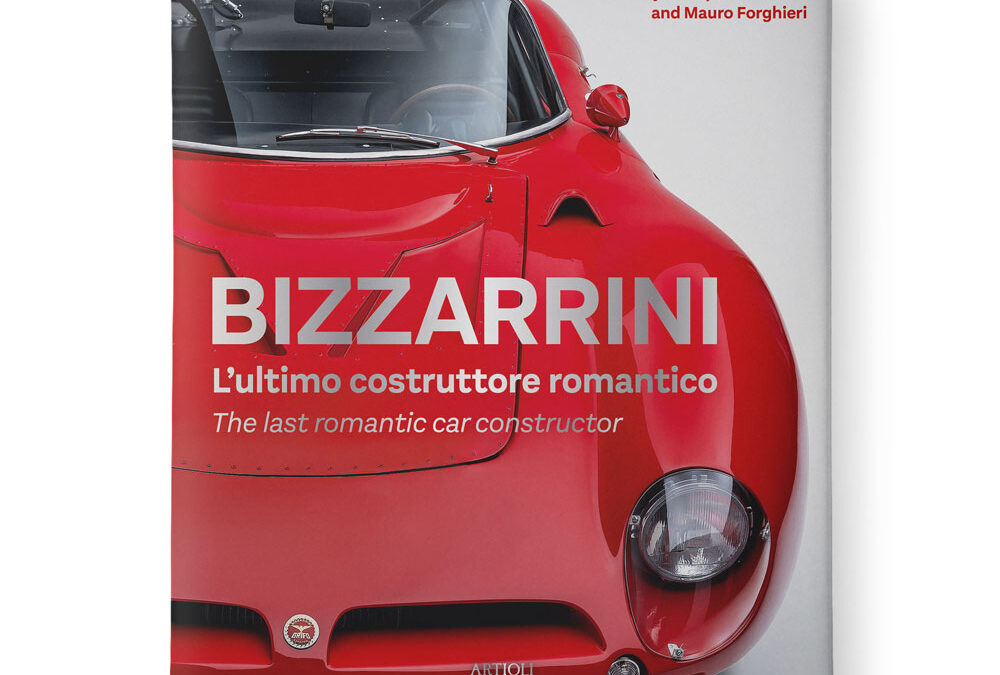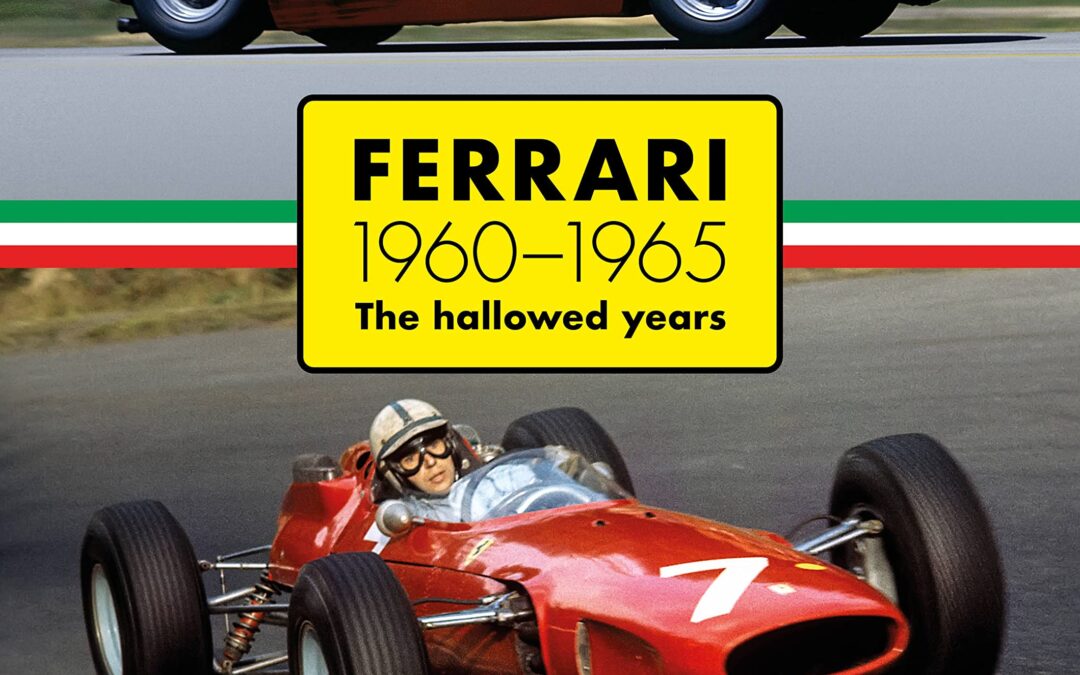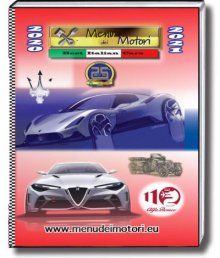
Everything you need to completely restore your 1947-1955 first series Chevy pickup to better-than-new condition is shown in complete detail!
The Advance Design era (1947-1955) was historic for Chevrolet, topping all the production numbers every year they were in production. And for good reason. The post-World War II economy demanded a tough and well-engineered solution for this growing economy. Selling more than 2.5 million units during this era, Chevrolet quickly surpassed and controlled the light-truck market with style, utility, and logical engineering.
This era has been overlooked for long enough, and Deve Krehbiel, a well-known restoration expert from DevesTechNet.com who specializes in these trucks, puts his 40 years of experience restoring nothing but Advance Design trucks into an extensive and complete single volume. With more than 500 photos and detailed instruction for every aspect of a proper restoration, this book will be the restorer’s best friend. Deve’s companion book, Chevrolet Inline 6 Engine: 1929-1962 (SA455), explains in full detail the engine aspects of your project.
The Advance Design Chevy pickup is one of the most popular and highly prized vehicles at any venue. The author’s hope is that this book will give you the confidence and the knowledge to put your old Chevy truck back on the road in style. There is just nothing more interesting and more inviting than an old Chevy truck!
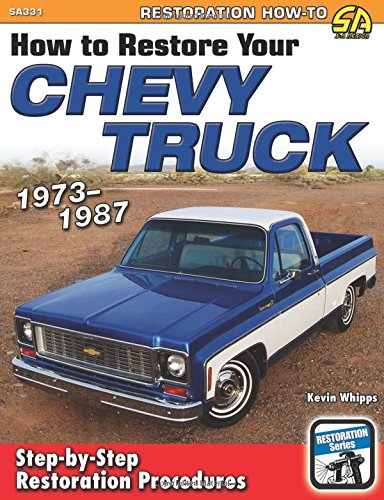
Whether your 1973-1987 Chevy truck is a regular, super, or crew cab with a short or long box, this restoration guide provides the pertinent information and instruction to restore your squarebody truck to original condition.
Seasoned truck magazine writer Kevin Whipps explains real-world techniques for restoring classic Chevrolet and GMC trucks at home. In How to Restore Your Chevy Truck: 1973-1987, you are shown how to comprehensively inspect, properly assess, and accurately budget your restoration project. You are also guided through each major portion of truck restoration, including the engine, suspension, chassis, bodywork, paint, brakes, steering, transmission, driveline, electrical system, interior, and more. Special coverage is dedicated to the replacement of body panels and repair of the box, cab, and other body parts. When pro-caliber bodywork has been performed, you have an excellent foundation for the paint, and in turn, you’re shown how to prep, shoot, and buff the paint job. As an on- and off-road utility vehicle, Chevy/GMC trucks have been towing, hauling, and operating in a variety of conditions. After all of these years of hard use and exposure to harsh conditions, many of these extensively used trucks are in desperate need of restoration.
When Chevy released its third-generation C/K pickup trucks, the stout and sturdy performers captured the attention of Chevy and GMC truck enthusiasts. As a result, millions were sold during their 18-year production run. The new cab design featured rounded windshield corners, a rounded cab roof, and sloped and rounded doors, so they were called the “rounded-line” trucks by General Motors. Enthusiasts, however, didn’t agree. Because of the overall squarer appearance of the trucks, they were soon called the “squarebody” by enthusiasts and journalists alike. Although the older Chevy/GMC pickups are more exclusive, the third-generation pickups are plentiful, increasing in collector value, and, fortunately, they have parts that are readily available.
Chevy/GMC trucks are extremely popular as stock restorations, fast street trucks, and off-road-duty trucks. But before you can build a specialty truck, you need to have a solid, reliable, restored truck. This book provides the invaluable information and step-by-step instruction to return these trucks to their original glory. An authoritative and comprehensive restoration guide for the 1973-1987 Chevy/GMC trucks has not been available until now.

YOUR step-by-step colour illustrated guide to complete restoration
Written by an enthusiast with many years experience of working on classic British motorcycles – but with little experience of working on these iconic machines – this book covers the complete dismantling, refurbishment, and rebuilding of two Tridents: a 1973 Triumph T150V and a 1975 Triumph T160. Written from a the point of view of a relative novice, it covers all parts of the rebuild in great detail; parts that other manuals gloss over, leaving the novice confused and frustrated.
From the simplest of jobs, such as removing the oil tank, through to detailed explanations of rebuilding the engine and carburettors, this manual is an absolute must for any enthusiast contemplating working on their triple. Over 650 colour photographs and detailed text descriptions clarify every stage … engine, gearbox, clutch, electrics, frame, wheels, forks, swinging arm, brakes, instruments … the whole bike!
Highly readable, and written with, the author readily admits to the various pitfalls and mistakes he makes in order for others to avoid them.
Designed to sit alongside existing workshop manuals, this book is intended to help the owner make sense of them all, and enable them to complete any operations that are omitted from the other books – of which there are many. Essential garage literature.

“Antique Auto Body Decoration Work for the Restorer” Find out how to stripe, ornament, or monogram your antique vehicle. Period experts will teach you the basics of striping, such as filling the brush, holding the brush, and the mechanics of the brush stroke. You will also learn techniques for lettering, scrolling, transfer ornamenting, monogramming, ornamenting, and cane work imitating as they were practiced on the first motor cars. You will find out about the best pencils and brushes to use. There are 225 illustrations including 100 line drawings detailing striping, spoke and scroll design and early commercial car lettering, and 100 more depicting representative monograms and family crests. Once you have absorbed the techniques that will allow you turn your restoration into a masterpiece, this book will serve as an excellent reference for authentic letter and ornament styles to draw from. This volume represents three generations of expertise. The book is compiled from “The Complete Carriage and Wagon Painter” (1887) by Fritz Schriber (carriage techniques are the same as those used on cars, and this book was very well written), with excerpts and references to “The Carriage Monthly Magazine” (1913-1914) and “The Coachmaker’s Illustrated Handbook” (1917), the complete article by John C. Crim “The Sword Striping Brush, It’s Use and Handling” (1956) and other masters’ texts.127 pages, softbound. Year Application-General.
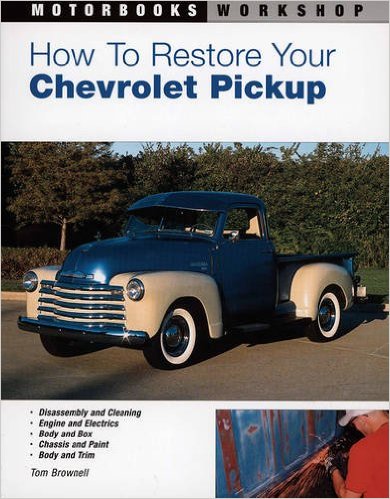
A new edition of one of our more popular how-to titles, incorporating an attractive design, significantly updated text, and full-color photography. This is a step-by-step restoration guide for all Chevy light-duty trucks from 1928 onwards.Updates include:- Upgrading to power steering- Pressure oiling for “Stovebolt” six and electronic fuel injection upgrades- New information on disc brakes and power brakes.
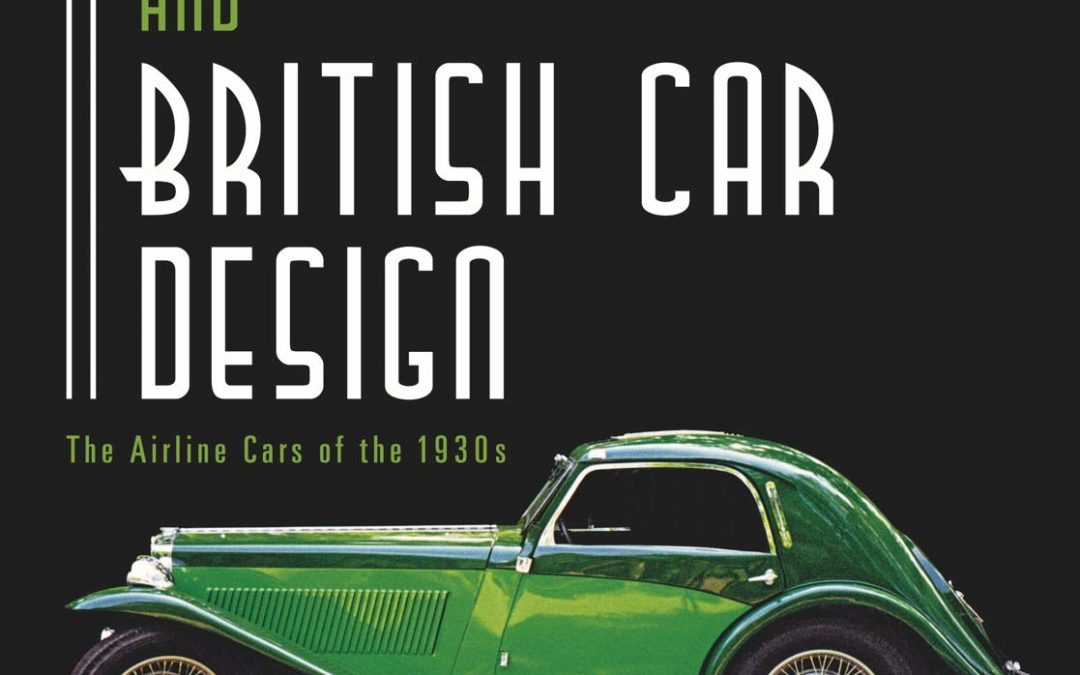
Art Deco and British Car Design is a book about automotive styling, in particular the streamlined styling that defined what are now known as Airline cars. During the mid-1930s, the majority of British car manufacturers and coach builders experimented with streamlined styling. This fashion was the result of Art Deco, an international movement that influenced design and marketing in many different industries, and produced some of the most unique and visually exhilarating cars ever produced in Britain.
Part One of the book explains and illustrates the Art Deco styling elements that link these streamlined car designs, and describes their development, their commonality, and their unique aeronautical names. The stories of the individual cars, their designers, and their development, are told in Part Two. Here, Barrie Down has collected examples of all the significant British streamlined production cars made between 1933 and 1936, many of them still represented by beautifully restored survivors.
The book is well illustrated with over 200 contemporary pictures and colour photographs of existing cars, many of which have never before been published. Art Deco and British Car Design is an instructive and visual feast for all car lovers.
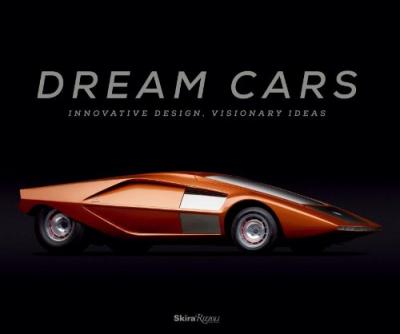
A sensuously designed showcase of covetable concept or limited-edition cars by the best American and European manufacturers. Dream Cars presents some of the world’s most breathtaking concept cars built between 1934 and 2001, a series of visionary designs that influenced the automotive industry and challenged notions of what is possible both aesthetically and technologically. Stunning all-new photography of design pioneers such as the 1935 Bugatti Type 57 Aerolithe, the 1951 LeSabre concept car, and the 1954 Alfa Romeo B.A.T. 7 accompany lush images of dream sports cars, including the 1970 Ferrari Modulo and the 1955 Ghia Streamline X “Gilda.” Meticulously restored and brought to life by all-new photography, these images trace a lineage of innovation in automobile design.
Comprehensive descriptions by celebrated automotive writer Ken Gross as well as drawings and scaled models further illustrate the imaginative force of individual designers and famed manufacturers. Surprising insights into familiar models like the minivan, based on the streamlined silhouette of the Stout Scarab concept car developed in 1936, are juxtaposed with startling new technologies such as the 2001 BMW GINA Light Visionary Model’s ingenious use of fabric as a retractable skin. An extended essay by Sarah Schleuning explores the effects of aerodynamics and aeronautics on car design and considers how groundbreaking events-such as General Motors’s Motorama-fueled the creativity of automobile styles.

This book is unique. It not only tells you how carburetors work – but more importantly – why.
Carburetors, like many parts of a car, are not stand-alone devices. A carburetor’s “success” is highly dependent on many related components working together, just like the members of a football team must work together in order to win. We will discuss all aspects of the fuel and air systems of a gasoline engine from the gas tank until the air-fuel mixture enters the combustion chamber. To be able to effectively understand, diagnose and repair carburetors, it is important to understand all of these inter-related systems.
This book will complement the various service manuals you have for your cars. Some books have very good, detailed carburetor descriptions, while others are limited in the discussion of how the particular carburetor works. This book is not intended to replace these manuals, but to give you fundamental knowledge that will apply to virtually all carburetor designs. This book also includes more than just carburetor information, since it is the complete fuel, air, ignition and intake manifold systems that are important to fully understand your vehicle.
Over the past several years, I have been studying the Marvel carburetor calibrations on early Buicks and reporting the results in my “Early Buick and McLaughlin-Buick Owners” newsletter. The variation in air–fuel ratio (A/F) I observed on my 1916 and 1929 Buicks led me to do a more detailed analysis of intake manifold designs, which are critical to achieving an optimum carburetor calibration. It is interesting to see how both intake manifold designs and fuel delivery techniques evolved over the last 100 years.
In addition to my own antique cars, I have been involved in some interesting restorations of historically significant General Motor vehicles. I restored three carburetors used on the restoration of the GM Futurliner #10 and rebuilt the four side-draft carburetors used on the 1956X Buick concept car both restored by my good friend Don Mayton in Michigan. While both vehicles used standard production carburetors, the unique applications made them an interesting and rewarding experience.
The book discusses all aspects of the engine’s demand for air and fuel, how it is achieved and how engine designs affect carburetion. We will trace the carburetor’s evolution from the simple carburetors in the early 1900s, through the more complicated carburetors in the mid-1980s. We will see how emission regulations changed carburetors in the 1970s and 1980s, and ultimately led to electronically controlled fuel injection today. I will also use many analogies to help you understand the concepts in carburetors and fuel systems.
Enjoy and learn.
Dean G. Tryon

Host Lloyd Bridges takes you on a tour of motorsports in the 60’s. Cobra test at Riverside with Ken Miles, Shelby driver of the era. See the 007 Bond Aston Martin and Sean Connery, slot car racing, bubbletops, Craig Breedlove at salt flats, classic drag racing, and big daddy Ed Roth. This is a 40 min. transport back in time. You will be light-headed watching this show. It is the complete uncut version broadcast Thursday, Sept 8, 1967, on CBS. This is a digital re-master directly from film. It looks great! Bonus
Feature: Motor Mouth Pilot
Live the time machine from 1967 to 2002. See how when things change they really stay the same! Take a ride with hosts Barbi Orr and Jane Norris as they run their motor mouth at events like Willow Springs, You will see many cars from the 60’s still racing today: Cobras, GT350, Vettes, and many others. Also celebrity interviews – see how today’s high-tech BLING BLING WHEELS are designed by Keith Kaucher (today’s top wheel designer). Go to a hidden speed shop in Culver City, Calif., where top master mechanic Steve Beck stores the rarest cars you’ll ever see!
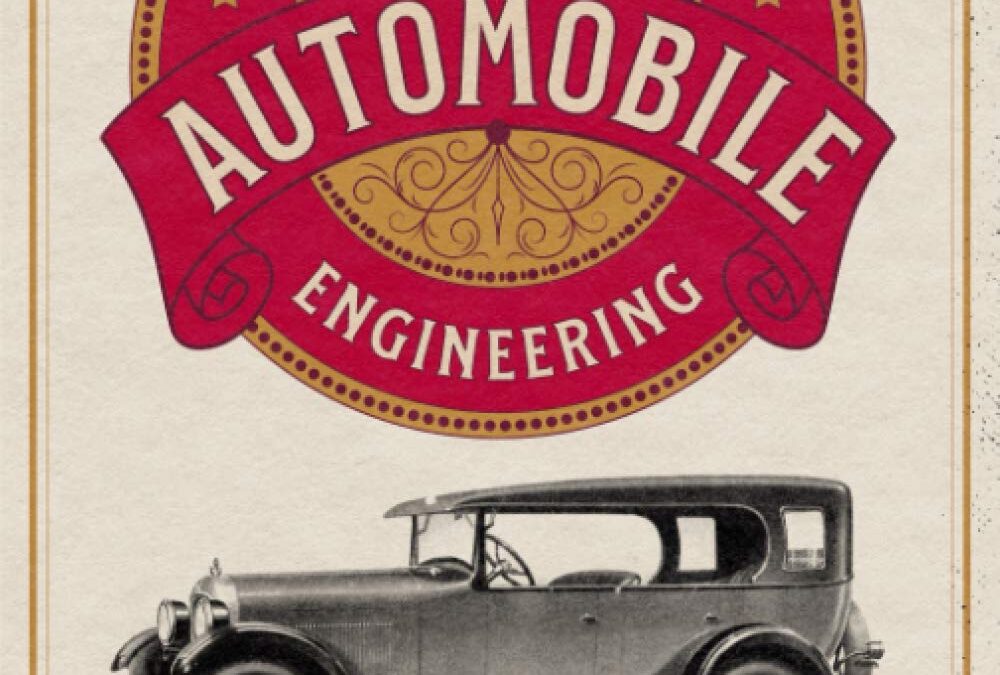
Volume 5 concludes the in-depth five-part series with detailed antique car wiring diagrams, data sheets, and a thorough look at classic electrical systems.
The Classic Cars and Automobile Engineering series spans five volumes with more than 1500 images and diagrams for enthusiasts, collectors, and mechanics. Volume 5 includes:
– Digitally restored images and diagrams
– Big 7” x 10” pages
– Easy to read writing style
– Author’s original page layouts
– Classic type font and hand-drawn lettering
– Bold retro-style cover
Everything that you ever wanted to know about the inner workings of antique cars, trucks, bikes, engines, tractors and more are included in this expansive tome of knowledge. Originally printed in 1926, this vast wealth of knowledge for classic car lovers was digitally restored and enhanced by writer-historian Mark Bussler and the CGR Publishing Restoration Workshop for a new generation of automobile enthusiasts.
This detailed, illustrated book collection is a must-have reference guide for all owners of period automobiles, motorcycles, airplanes, and anything powered by early 20th-century engines. Enlarged and printed on large 7” by 10” pages, The Classic Cars and Automobile Engineering series is designed for easy reading in the shop or library. Volume 5 focuses on electrical systems, wiring diagrams and data sheets.
Included subjects: How to read wiring diagrams – symbols – charts – generators – lamp voltages – dimming devices – electric horns – ignition timing – spark plugs – distributors – currents – methods of regulation – proper conduction – hydrometer tests – low battery – electric gear shifts – and more.
Includes wiring diagrams and datasheets for Apperson, Buick, Cadillac, Case, Chalmers, Chandler, Chevrolet, Chrysler, Cleveland, Cole, Cunningham, Davis, Dodge, Dort, Duesenberg, Durant, Essex, Ford, Flint, Franklin, Gardner, Gray, Haynes, Hudson, Hupmobile, Jackson, Jewett, Jordan, Kissel, LaFayette, Lexington, Lincoln, Marmon, Maxwell, Mercer, Moon, Nash, National, Oakland, Oldsmobile, Overland, Package, Paige, Peerless, Pierce-Arrow, Rco, Rickenbacker, Rollin, Rolls-Royce, R&V Knight, Star, Stephens, Studebaker, Stutz, Wills Sainte Claire, Willys-Knight, and Winton.
Table of contents:
– Chapter 1: Reading Wiring Diagrams and Auxiliary Electrical Equipment
– Chapter 2: Wiring Diagrams and Data Sheets
– Chapter 3: Summary of Electrical Principles
– Chapter 4: Ignition Instructions
– Chapter 5: Generators
– Chapter 6: Wiring Systems
– Chapter 7: Battery
– Chapter 8: Glossary of Automobile Terms
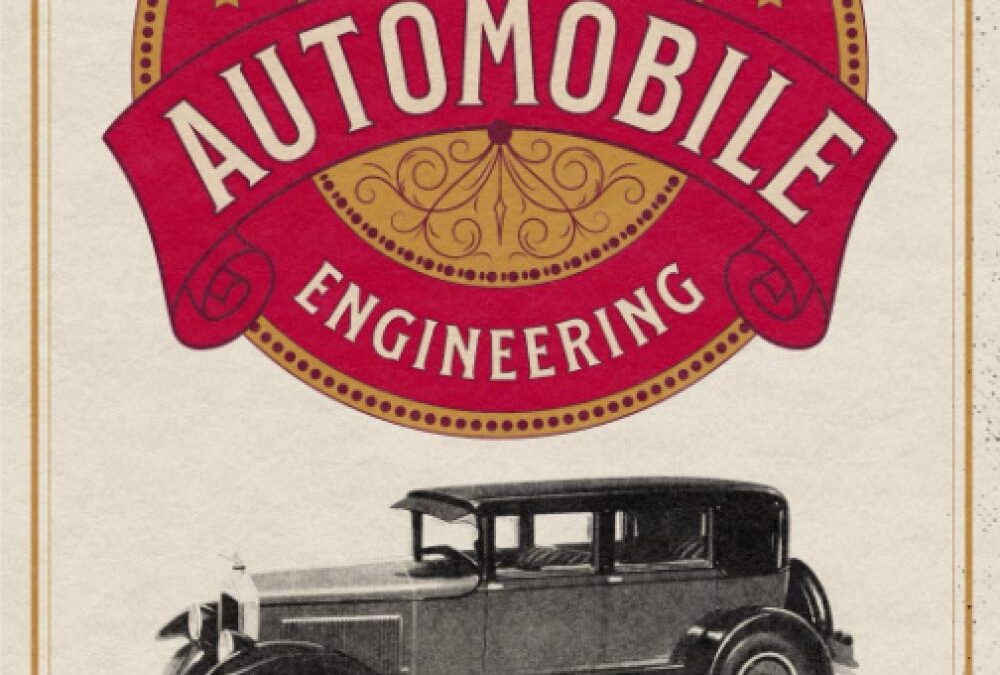
Volume 4 in this illustrated five-part series highlights ignitions, starters, generators, batteries, and electrical repairs.
The Classic Cars and Automobile Engineering series spans five volumes with more than 1500 images and diagrams for enthusiasts, collectors, and mechanics. Volume 4 includes:
– Digitally restored images and diagrams
– Big 7” x 10” pages
– Easy to read writing style
– Author’s original page layouts
– Classic type font and hand-drawn lettering
– Bold retro-style cover
Everything that you ever wanted to know about the inner workings of antique cars, trucks, bikes, engines, tractors, and more are included in this expansive tome of knowledge. Originally printed in 1926, this vast wealth of knowledge for classic car lovers was digitally restored and enhanced by writer-historian Mark Bussler and the CGR Publishing Restoration Workshop for a new generation of automobile enthusiasts.
This detailed, illustrated book collection is a must-have reference guide for all owners of period automobiles, motorcycles, airplanes, and anything powered by early 20th-century engines. Enlarged and printed on large 7” by 10” pages, The Classic Cars and Automobile Engineering series is designed for easy reading in the shop or library. Volume 4 focuses on electrical equipment and features elementary classic car electric system workings, ignition fundamentals, batteries, electrical repair, starting motors, and more.
Specific detailed subjects include magnetism, poles, laws, magnetic substances, dynamos, armature windings, field magnets, induction, self-induction, source of current, magnetos, spark plugs, induction coils, spark timing, magneto speeds, types of wiring systems, battery charging, cleaning a battery, replacing a jar, Edison Cell care, testing equipment, lamp troubles, and much more.
Table of contents:
– Chapter 1: Electrical Principles
– Chapter 2: Ignition Fundamentals
– Chapter 3: Ignition Systems
– Chapter 4: Ignition Operations
– Chapter 5: Motors
– Chapter 6: Generators
– Chapter 7: Storage Batteries
– Chapter 8: Electrical Repairs
– Chapter 9: Ford Car Electrical System
– Chapter 10: Ohm’s Law
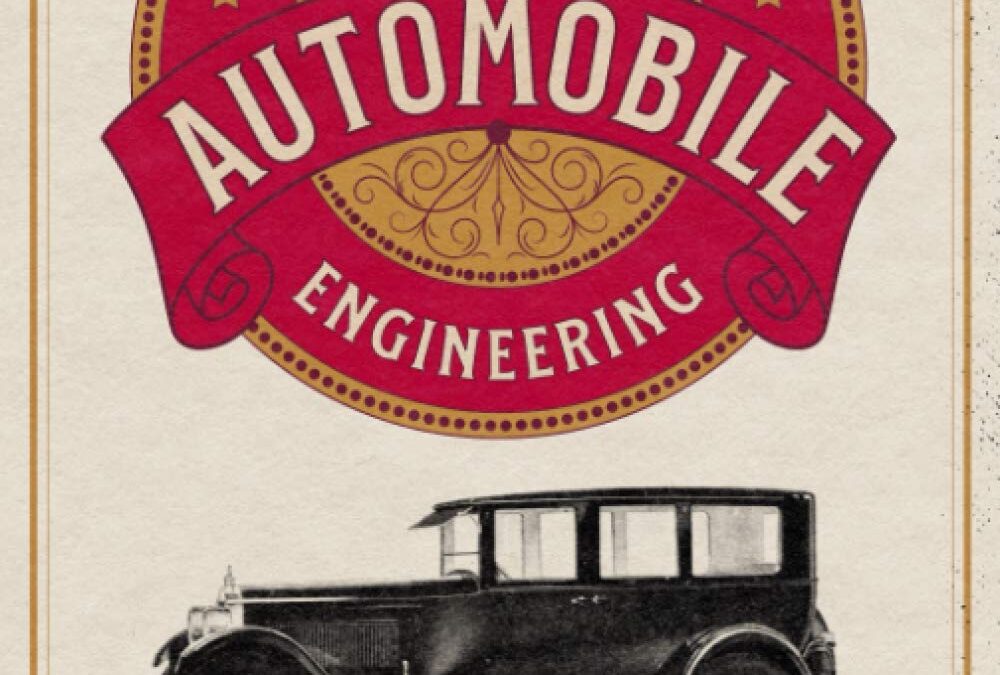
Volume 3 in this illustrated five-part series highlights antique motorcycles, tractors, airplane engines, period welding techniques, and Q&A.
The Classic Cars and Automobile Engineering series spans five volumes with more than 1500 images and diagrams for enthusiasts, collectors, and mechanics. Volume 3 includes:
– Digitally restored images and diagrams
– Big 7” x 10” pages
– Easy to read writing style
– Author’s original page layouts
– Classic type font and hand-drawn lettering
– Bold retro-style cover
Everything that you ever wanted to know about the inner workings of antique cars, motorcycles, engines, tractors and more are included in this expansive tome of knowledge. Originally printed in 1926, this vast wealth of knowledge for classic car and bike lovers was digitally restored and enhanced by writer-historian Mark Bussler and the CGR Publishing Restoration Workshop for a new generation of automobile and classic motorcycle enthusiasts.
This detailed, illustrated book collection is a must-have reference guide for all owners of period automobiles, motorcycles, airplanes, and anything powered by early 20th-century engines. Enlarged and printed on large 7” by 10” pages, The Classic Cars and Automobile Engineering series is designed for easy reading in the shop or library. Subjects covered in Volume 3 include antique motorcycles with illustrations of classic Harley-Davidson models such as the Twin-Cylinder Three-Speed Motorcycle, Thor lightweight bikes, The Merkel Motorcycle, Dayton Motor Bicycle, a detailed Excelsior Motorcycle diagram, and more.
Aviation engines are covered in detail from manufacturers such as King-Bugatti, Curtiss, Liberty, Packard, and Sunbeam. Tractors, air-cleaners, oils, ignitions, workbenches, blowtorches, micrometers, tool grinding, drill presses, gases, arc welding, types of welds, after-treatment, and much more are covered with numerous detailed illustrations.
Table of contents:
– Chapter 1: Motorcycles
– Chapter 2: Aviation Engines
– Chapter 3: Gasoline Tractors
– Chapter 4: Shop Information
– Chapter 5: Oxy-Acetylene Welding Practice
– Chapter 6: Questions and Answers
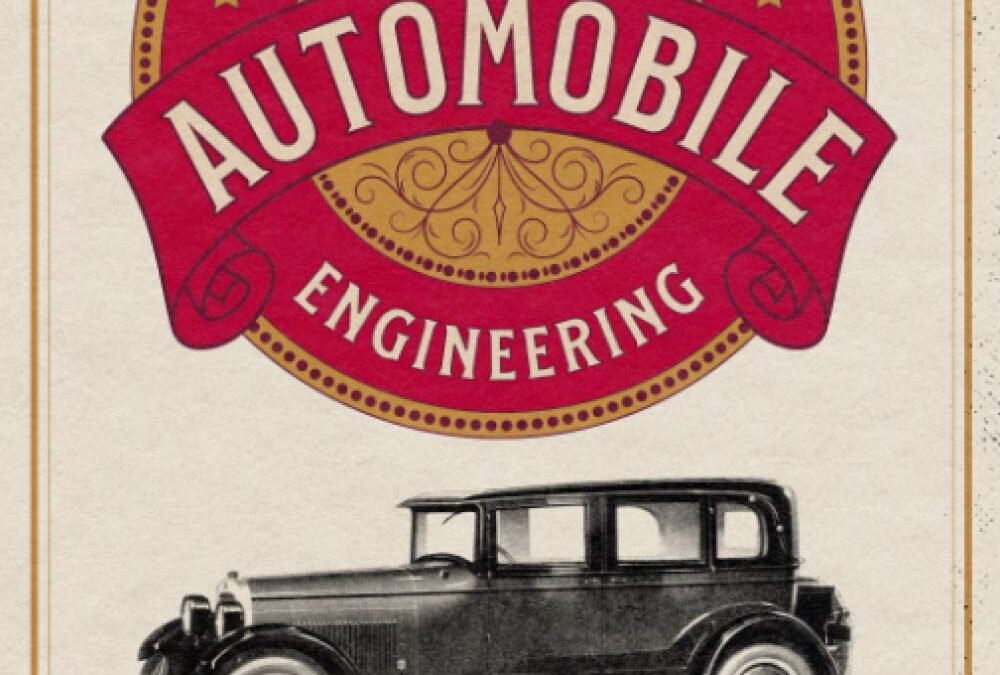
Part 2 of the definitive five-part book series about classic automobile engineering covers transmissions, brakes, wheels, tires, and more.
The Classic Cars and Automobile Engineering series spans five volumes with more than 1500 images and diagrams for enthusiasts, collectors, and mechanics. Includes:
– Digitally restored images and diagrams
– Big 7” x 10” pages
– Easy to read writing style
– Author’s original page layouts
– Classic type font and hand-drawn lettering
– Bold retro-style cover
Everything that you ever wanted to know about the inner workings of antique cars, trucks, bikes, engines, tractors, and more is included in this expansive tome of knowledge. Originally printed in 1926, this vast wealth of knowledge for classic car lovers was digitally restored and enhanced by writer-historian Mark Bussler and the CGR Publishing Restoration Workshop for a new generation of automobile enthusiasts.
This detailed, illustrated book collection is a must-have reference guide for all owners of period automobiles, motorcycles, and anything powered by early 20th-century engines. Enlarged and printed on large 7” by 10” pages, The Classic Cars and Automobile Engineering series is designed for easy reading in the shop or library. Subjects covered in Volume 2 include transmissions, axles, brakes, wheels, tires, and classic Fords.
Table of contents:
– Chapter 1: Transmissions
– Chapter 2: Rear Axles and Final Drive
– Chapter 3: Brakes
– Chapter 4: Steering Apparatus
– Chapter 5: Frames and Special Type of Drive
– Chapter 6: Springs and Shock Absorbers
– Chapter 7: Front Axles and Bearings
– Chapter 8: Wheels
– Chapter 9: Rims
– Chapter 10: Tires
– Chapter 11: Ford Construction and Repair
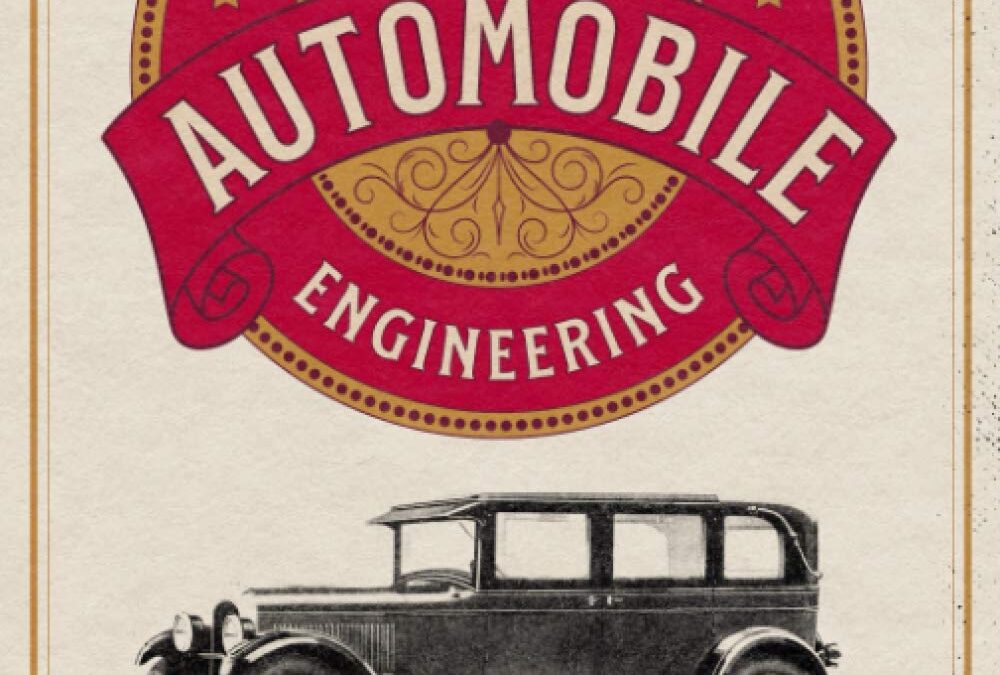
The definitive five-part book series about classic automobile engineering starts here with Volume 1.
The Classic Cars and Automobile Engineering series spans five volumes with more than 1500 images and diagrams for enthusiasts, collectors, and mechanics. Includes:
– Digitally restored images and diagrams
– Big 7” x 10” pages
– Easy to read writing style
– Author’s original page layouts
– Classic type font and hand-drawn lettering
– Bold retro-style cover
Everything that you ever wanted to know about the inner workings of antique cars, trucks, bikes, engines, tractors, and more is included in this expansive tome of knowledge. Originally printed in 1926 by the American Technical Society, this vast wealth of knowledge for classic car lovers was digitally restored and enhanced by writer-historian Mark Bussler and the CGR Publishing Restoration Workshop for a new generation of automobile enthusiasts.
This detailed, illustrated book collection is a must-have reference guide for all owners of period automobiles, motorcycles, and anything powered by early 20th-century engines. Enlarged and printed on large 7” by 10” pages, The Classic Cars and Automobile Engineering series is designed for easy reading in the shop or library. Subjects covered in Volume 1 include elementary engine principles – spark plug position – throttle valves – the inner workings of cylinders – crankshaft balance – water cooling systems – cone, disc, hydraulic, borg and beck clutches – four-cylinder, six-cylinder, eight-cylinder, and twelve-cylinder engines – much more.
Table of contents:
– Chapter 1: Outline of Automobile Construction
– Chapter 2: Explosion Engines
– Chapter 3: Cylinders
– Chapter 4: Pistons
– Chapter 5: Valves and Their Mechanism
– Chapter 6: Camshafts
– Chapter 7: Connecting Rods
– Chapter 8: Crankshafts
– Chapter 9: Crankcases
– Chapter 10: Carburetors
– Chapter 11: Cooling Systems
– Chapter 12: Manifold Design and Construction
– Chapter 13: Clutches
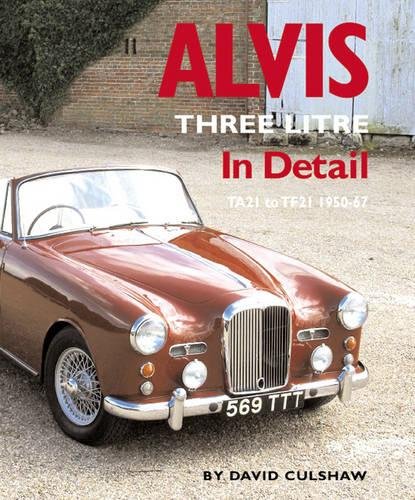
From its launch in 1950 to its demise in 1967, the Alvis Three Litre enjoyed a deserved reputation for effortless performance, exceptional surefootedness and stability, a high degree of driver friendliness, and irreproachable quality of construction. It was considered a rather exclusive car, coming as it did from a maker whose products always had a certain individuality. In addition, there remained through successive models something reassuringly traditional about its styling in both saloon and drophead forms; while never outdated, it displayed a timeless, discreet dignity unmoved by the more frivolous vagaries of fashion. All the while, in the background but ready to serve when called upon, was the Alvis works, whose concern for its cars and their owners was exemplary.Throughout production, the Three Litre was based on the same chassis and was powered by the same engine. This was a handsome and efficient short-stroke six-cylinder, conceived in order to provide the driver with ample power over a very wide rev range. Starting with an output of 83bhp in the early TA21, this robust unit was progressively developed to supply 150bhp in its final TF21 form while retaining the turbine smoothness, reliability and lack of temperament that it had become celebrated for. It was perfectly matched to its chassis and running gear, and those who have driven a Three Litre at speed will find the dynamic qualities of the contemporary rivals from Bentley or Jaguar rather less likeable.This book opens with an exposition of the background that led to the companys introduction of the Three Litre in 1950. Then comes a detailed technical analysis of the TA21, covering all aspects of the chassis, running gear, engine and transmission. This sets the scene for the chapters which follow, on the short-lived TB21 sports tourer, the TC21 and the uprated TC21/100, the Graber-inspired TC108G, the outstandingly handsome TD21 Series I and II, the TE21 and the TF21.Each of these receives comprehensive treatment, including differences from previous models, production changes and full chassis number number listings, along with notes on famous owners and screen appearances. The author provides extensive information on the coachbuilders who supplied Three Litre bodies, including Mulliners, Tickford, Graber, Willowbrook and Park Ward, and there are chapters devoted to the Alvis-powered Healey G Series sports car, the aborted Issigonis-designed Alvis TA350, and the ownership and use of Alvis Three Litre models today.Five outstanding examples of the cars have been specially photographed for this book and are featured in some 70 colour shots. There are also more than 140 black-and-white illustrations drawn from archives as well as from Alvis sales and publicity material. Devoted exclusively to the Three Litre, this book offers an in-depth examination of these excellent cars to provide a store of information for the many owners who care passionately about them, and serve as a tribute to the men who made them.
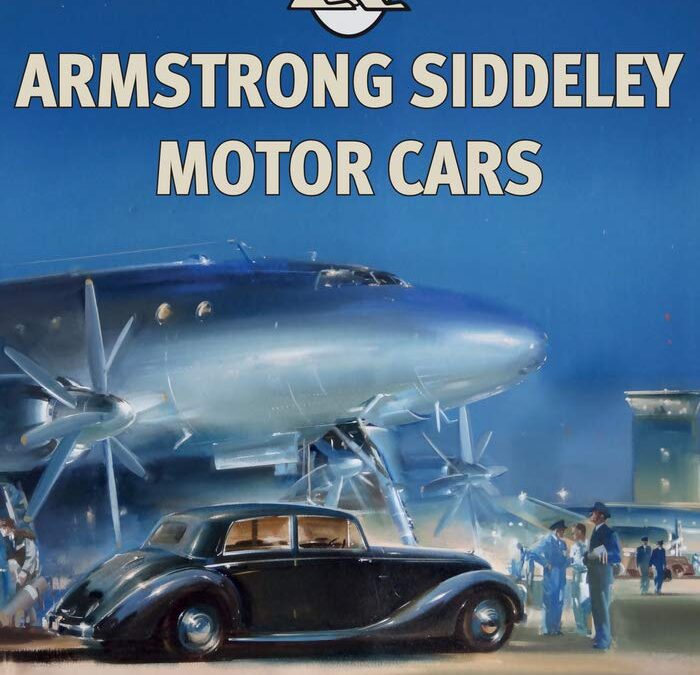
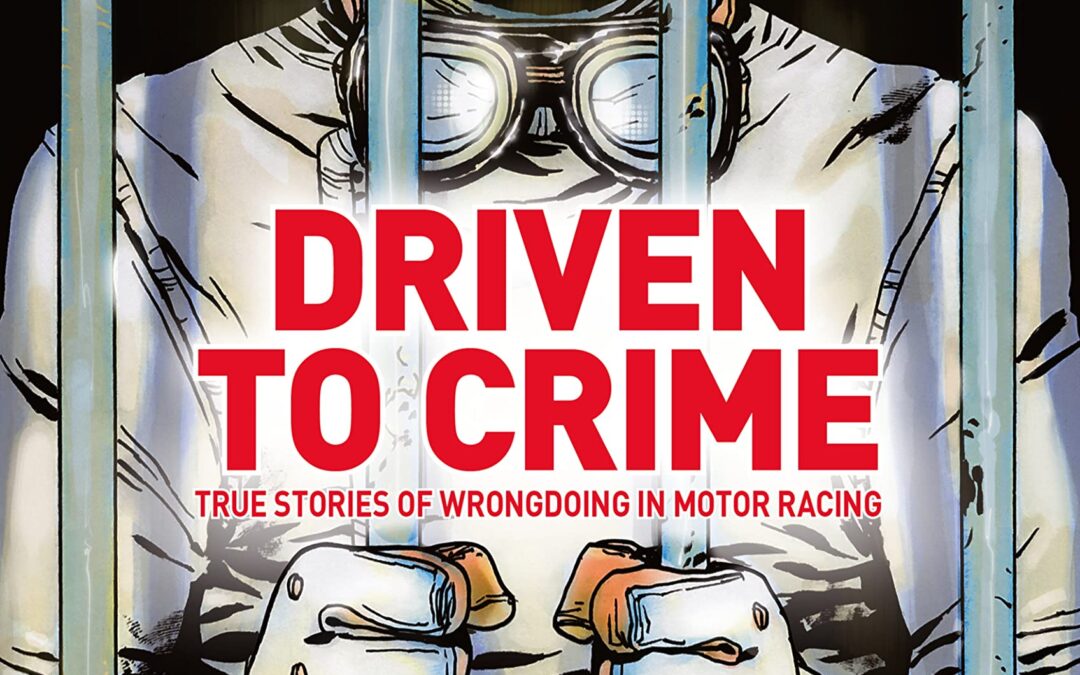
People lie, cheat, steal and even kill for a variety of reasons, one of which is to go motor racing, a particularly expensive and egotistical sport. This intriguing book, the result of years of research, encompasses not just those who have been ‘driven to crime’ in order to pay for their sport but also characters within motor racing who have been involved in wrongdoing, sometimes through no fault of their own.
Over 60 true stories cover webs of deceit and numerous crimes including drug trafficking, corruption, embezzlement, robbery, fraud, murder and money laundering. The author investigates misdemeanours at all levels, from drivers, designers and mechanics to team owners, entrants and sponsors.
- Stories of motorsport chicanery from all over the world, including…
- Fraud: Southern Organs (lay preachers who faked suicide and hid on a remote Scottish island); Jerry Dominelli (a Ponzi scheme that funded top-level racing Porsches); Jean-Pierre Van Rossem (self-styled stock-market guru who bankrolled an F1 team); Dominic Chappell (serial bankrupt racer brought down after purchasing a British department store); David Thieme (the Lotus sponsor who vanished).
- Murder: David Blakely (the driver killed by his lover Ruth Ellis); Franco Ambrosio (F1 sponsor of Shadow and Arrows); Elmer George (American racer who married into Indy ‘royalty’); Ricardo Londoño-Bridge (Colombia’s first F1 driver); Mickey Thompson (1960s American drag-racing icon); Nick Whiting (casualty of the biggest gold bullion heist in British history).
- Swindles: James Munroe (accounts manager who embezzled his way to a racing McLaren F1 GTR); Lord Brocket (jailed for staging the theft of his classic cars, including Ferraris); Andrea Harkness (stripper who ripped off NASCAR).
- Drugs: Ian Burgess (sometime British F1 racer); Randy Lanier (drug-smuggling IMSA champion); John Paul Sr and Jr (talented son dragged into a racing father’s drug-running); Vic Lee (super-successful team owner with a dodgy transporter); the Whittington brothers (more misdeeds in IMSA circles).
- Other misdemeanours: Roy James (Great Train Robbery getaway driver); Bertrand Gachot (jailed after road rage in London); Juan Manuel Fangio (kidnapped by Cuban rebels in 1958); Colin Chapman (the unresolved ‘DeLorean Affair’); ‘Spygate’ (Ferrari design secrets passed to McLaren).
This book will appeal not only to motor racing enthusiasts and cognoscenti on both sides of the Atlantic but also to anyone who enjoys reading about true crimes.









